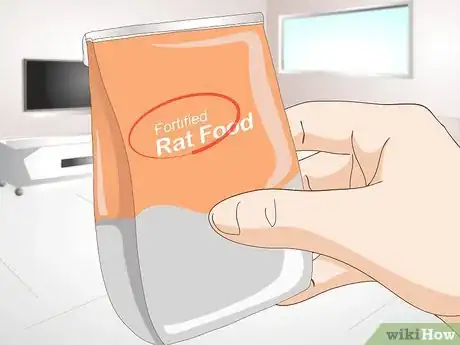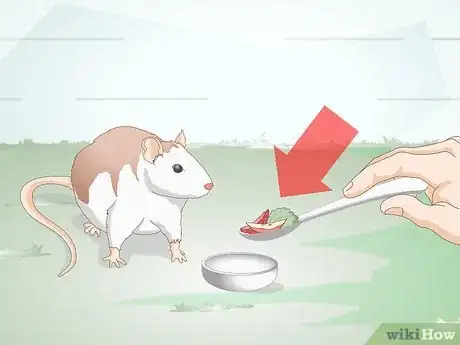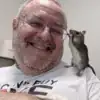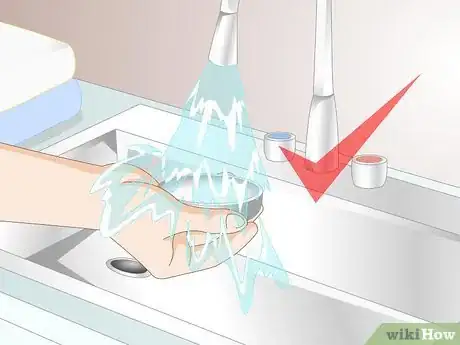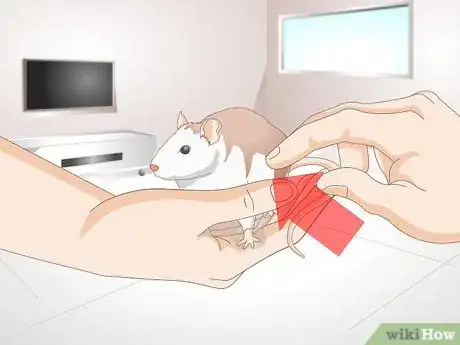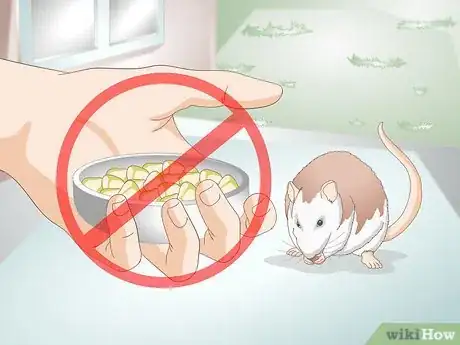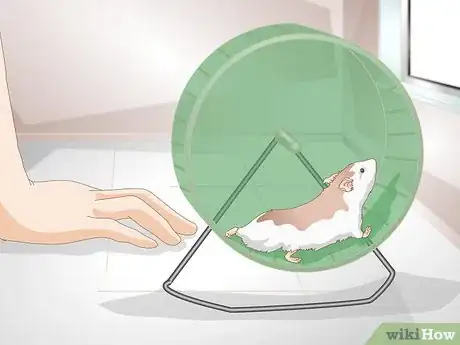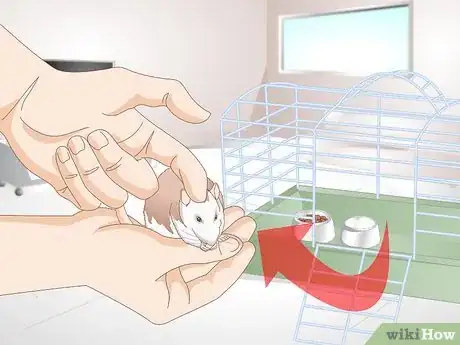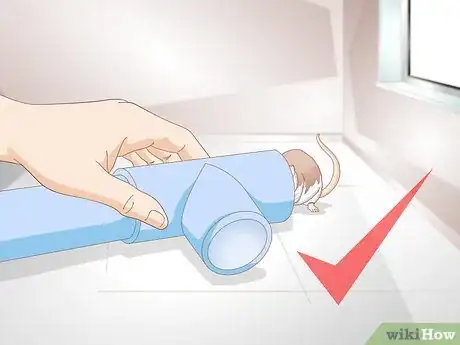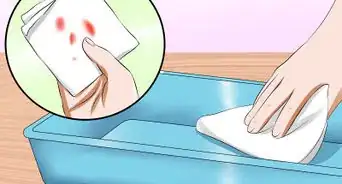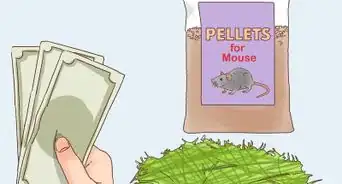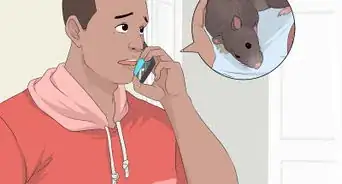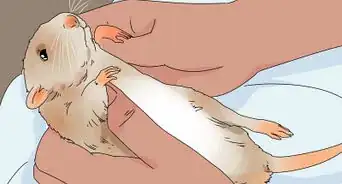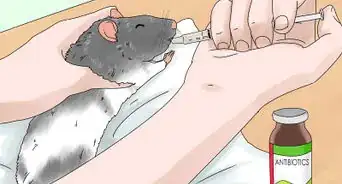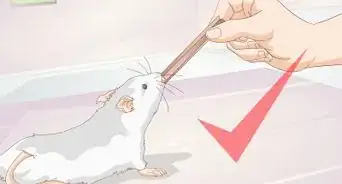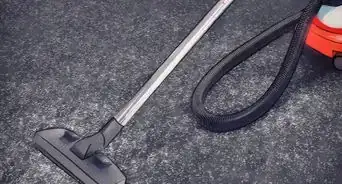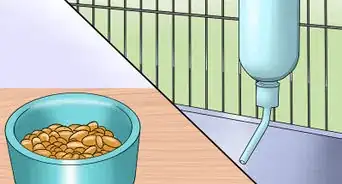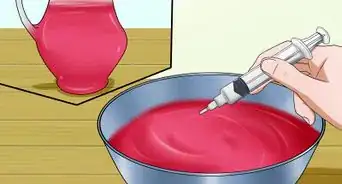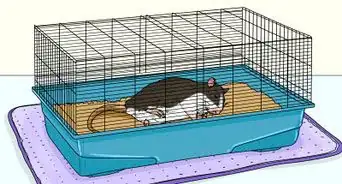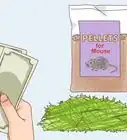This article was co-authored by Brian Starr. Brian Starr is a Rat Specialist and Breeder and the Owner of OC Dumbos out of Central Florida. As America’s only breeder of pet Roof Rats, Brian and OC Dumbos specialize in rat breeding, training, and care. Years of experience and several generations of careful breeding have allowed Brian and OC Dumbos to create a line of tame Roof Rats, bred to make friendly, fun pets. In addition to offering rat accessories and training resources, OC Dumbos also offers free Roof Rat adoptions.
wikiHow marks an article as reader-approved once it receives enough positive feedback. In this case, 100% of readers who voted found the article helpful, earning it our reader-approved status.
This article has been viewed 33,394 times.
Rats, like humans, are omnivores, which means that they will eat both plant matter and animals. Like humans as well, rats will often overeat out of nervousness, boredom, or being provided too much food. Rats are prone to obesity, which has consequences for their health. If your rat is overweight, you can help it lose weight by….
Steps
Providing a Healthy Diet
-
1Use a smaller feeding dish. A small ceramic (not plastic) food dish that’s only large enough to hold one feeding block will suffice. The larger the bowl, the more your rat will eat. Small bowls serve as natural portion control.
- Make sure your feeding bowl is sturdy so that it doesn’t tip over as your rat eats.
- Your rat may chew a plastic bowl.
-
2Provide fortified food. There are good quality commercial rat foods available through pet stores and veterinary offices. These foods can be found in either “block” or “seed” type forms, and a mixture of both is recommended. If you’re trying to help your rat lose weight, feed it no more than 3 tablespoons per day.[1]
- Rat blocks contain a complete supply of vitamins and minerals.
- Avoid the generic “rodent formula” foods available at pet stores, as these often don’t provide an adequate amount of protein for your rat.
Advertisement -
3Limit your rat’s treats. One tablespoon of chopped fruit or vegetable is the best treat for your rat. Including apples, strawberries, bananas, and squash as treats rather than regular part of your rat’s diet will help support its weight loss. Feed treats in a separate dish from your rats regular food and make sure to clean the treat bowl daily.
- Frozen peas in a dish of water is a wonderful summertime treat that your rat can enjoy year-round.
- Avoid sticky foods like peanut butter as they can create a choking hazard.
- Feed your rat a hard treat, like a dog biscuit, once per week to keep its teeth sharp.
- Like humans, rats will gain weight if they eat foods that are high in sugar and fat.[2]
-
4Feed your rat at night. Rats are nocturnal creatures by nature, which means they’ll tend to be most active during the nighttime hours. It’s good to feed them early in the evening, when they’re most likely to be alert and awake.[3]
- If you notice small stashes of food around its cage, it’s likely you’re overfeeding it and should cut back on the amount of food you’re providing.
- Don’t skip your rat’s meals, or your rat may become hungry, anxious and unhappy.
-
5Wash your rat’s food bowl daily. Make sure that it doesn’t get caked with old food, which can lead to diseases. Scrub old food off with a wire brush or sponge, and use plenty of soap and water. Allow the food bowl to air dry.[4]
- It’s a good idea to wash out the food bowl at the same time as you clean out the rest of your rat’s cage.
- Place your rat’s food bowl at an opposite end of the cage from the rat’s bathroom area.
-
6Check for specific conditions. If your rat looks like it’s gained weight, it’s possible that it’s pregnant, particularly if you have more than one rat. The most common reason for bloated-looking abdomen in rats is pregnancy. For any medical conditions in rats, you’ll want to consult with your veterinarian.[5] Other possible conditions that may result in increased size include:
- A tumor in the abdomen. Not only can the tumor cause a bulge in the abdomen, but it can also cause fluid to accumulate in the abdomen.
- Liver and kidney disease, which can cause fluid build up in the abdomen.
- Megacolon is a condition of the nervous system, where the nerves to the large intestine don’t effectively allow for the colon to push out feces. As a result, the colon becomes backed up. Both the colon and the stools become larger than usual.
- Urinary blockage also can result in a rat’s appearing swollen and overweight. If the bladder is blocked, then the urine can become backed up, feeling like a balloon in the center lower abdomen.
-
7Steer clear of hazardous foods. While rats may enjoy a wide and varied diet similar to your own, there are certain foods that are hazardous to your rat. Dried corn, for example, has high levels of fungal contaminants which have been linked to liver cancer in rats.[6]
- You’ll also want to limit the amount of nitrates in your rat’s diet. Nitrates are found in beets, celery, eggplant, lettuce, cucumber, radishes, spinach, collards and turnip greens.
- Never give your rat any food that’s moldy or spoiled.
Increasing Your Rat’s Activity Level
-
1Provide plenty of exercise for your rat. Rats are intelligent animals who need a great deal of mental stimulation and activity. If you’re trying to help your rat lose weight, making sure it has plenty of activities will help it stay healthy and happy.
- Provide tunnels, igloos, ropes, ladders, blocks, and child or baby safe toys for your rat to play with.
- Wooden gnawing blocks make great chew toys. You can also offer rawhide chew sticks or hard dog biscuits.
- Old soup bones or chicken bones are fine for a rat to chew on.
-
2Try an exercise wheel. Your rat might enjoy running on an exercise wheel, which is the rodent-version of a treadmill. Make sure the wheel you find is large enough for your rat, and solid (or with very small mesh) to protect the rats’ feet and to avoid a rat tail being caught and damaged.[7]
- Never get a metal wheel with rungs or a crossbar which could get your rat’s tail tangled in it.
- Not all rats will enjoy running on an exercise wheel, and some may use it only for napping. However, for those rats who do enjoy it, an exercise wheel can be a great way to run off excess energy.
-
3Play every day with your rat. The best thing you can do for your rat is to make sure it has plenty of social interaction with you and your family. Rats are very social, and will get bored and unhappy if left too often alone.[8]
- Take your rat out of his cage for at least an hour every day, snuggling and petting him.
- It’s a good idea to keep him within one room at a time, with the door closed, so that he can safely explore the whole room.
-
4Make your own toys. Your rat will be happy to play with any number of homemade toys. Give him paper towel tubes or PVC pipes to run through. He’ll likely enjoy toys designed for birds, such as ladders, swings or anything he can gnaw on.[9]
- Find a branch from a fruit tree, and place it inside his cage. This will give him something he can climb on and something he can chew on.
- Keeping plenty of toys and activities around for your rat will keep him engaged and interested, and ultimately more healthy and happy.
Expert Q&A
-
QuestionWhat does a normal rat look like?
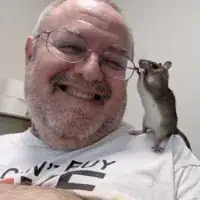 Brian StarrBrian Starr is a Rat Specialist and Breeder and the Owner of OC Dumbos out of Central Florida. As America’s only breeder of pet Roof Rats, Brian and OC Dumbos specialize in rat breeding, training, and care. Years of experience and several generations of careful breeding have allowed Brian and OC Dumbos to create a line of tame Roof Rats, bred to make friendly, fun pets. In addition to offering rat accessories and training resources, OC Dumbos also offers free Roof Rat adoptions.
Brian StarrBrian Starr is a Rat Specialist and Breeder and the Owner of OC Dumbos out of Central Florida. As America’s only breeder of pet Roof Rats, Brian and OC Dumbos specialize in rat breeding, training, and care. Years of experience and several generations of careful breeding have allowed Brian and OC Dumbos to create a line of tame Roof Rats, bred to make friendly, fun pets. In addition to offering rat accessories and training resources, OC Dumbos also offers free Roof Rat adoptions.
Rat Specialist & Breeder A normal rat looks like a cylinder with its shoulders, tummy, and hips roughly in the same plane. If a rat's tummy is significantly bigger than its shoulders and hips, it's probably overweight. Also, if you see rolls of fat hanging down from the rat, you can assume that it's overweight.
A normal rat looks like a cylinder with its shoulders, tummy, and hips roughly in the same plane. If a rat's tummy is significantly bigger than its shoulders and hips, it's probably overweight. Also, if you see rolls of fat hanging down from the rat, you can assume that it's overweight. -
QuestionHow do you tell if a rat is overweight?
 Brian StarrBrian Starr is a Rat Specialist and Breeder and the Owner of OC Dumbos out of Central Florida. As America’s only breeder of pet Roof Rats, Brian and OC Dumbos specialize in rat breeding, training, and care. Years of experience and several generations of careful breeding have allowed Brian and OC Dumbos to create a line of tame Roof Rats, bred to make friendly, fun pets. In addition to offering rat accessories and training resources, OC Dumbos also offers free Roof Rat adoptions.
Brian StarrBrian Starr is a Rat Specialist and Breeder and the Owner of OC Dumbos out of Central Florida. As America’s only breeder of pet Roof Rats, Brian and OC Dumbos specialize in rat breeding, training, and care. Years of experience and several generations of careful breeding have allowed Brian and OC Dumbos to create a line of tame Roof Rats, bred to make friendly, fun pets. In addition to offering rat accessories and training resources, OC Dumbos also offers free Roof Rat adoptions.
Rat Specialist & Breeder Check if the rat's weight seems to be interfering with its energy level or its ability to move around. It's very bad if their weight seems to be causing stress on its legs and joints; a lot of times, rats can develop problems with their feet or joints when they're overweight.
Check if the rat's weight seems to be interfering with its energy level or its ability to move around. It's very bad if their weight seems to be causing stress on its legs and joints; a lot of times, rats can develop problems with their feet or joints when they're overweight. -
QuestionDo rats get fatter as they get older?
 Brian StarrBrian Starr is a Rat Specialist and Breeder and the Owner of OC Dumbos out of Central Florida. As America’s only breeder of pet Roof Rats, Brian and OC Dumbos specialize in rat breeding, training, and care. Years of experience and several generations of careful breeding have allowed Brian and OC Dumbos to create a line of tame Roof Rats, bred to make friendly, fun pets. In addition to offering rat accessories and training resources, OC Dumbos also offers free Roof Rat adoptions.
Brian StarrBrian Starr is a Rat Specialist and Breeder and the Owner of OC Dumbos out of Central Florida. As America’s only breeder of pet Roof Rats, Brian and OC Dumbos specialize in rat breeding, training, and care. Years of experience and several generations of careful breeding have allowed Brian and OC Dumbos to create a line of tame Roof Rats, bred to make friendly, fun pets. In addition to offering rat accessories and training resources, OC Dumbos also offers free Roof Rat adoptions.
Rat Specialist & Breeder It depends on the species. Typically, male Norway rats tend to put on weight as they get older, even if you give them regular rat food.
It depends on the species. Typically, male Norway rats tend to put on weight as they get older, even if you give them regular rat food.
Warnings
- Fluoridated tap water is hazardous to rats. Make sure you only provide non-fluoridated water, such as well water, distilled water or spring water.⧼thumbs_response⧽
- Keep your rat away from blue cheese, licorice, bitter almonds, and poppy seeds. These foods are toxic to a rat.[10]⧼thumbs_response⧽
References
- ↑ http://ratfanclub.org/diet.html
- ↑ Brian Starr. Rat Specialist & Breeder. Expert Interview. 27 April 2021.
- ↑ http://www.humanesociety.org/animals/rats/tips/rat_feeding.html?credit=web_id85924277
- ↑ http://www.humanesociety.org/animals/rats/tips/rat_feeding.html?credit=web_id85924277
- ↑ http://www.ratfanclub.org/megacolon.html
- ↑ http://ratfanclub.org/diet.html
- ↑ http://animals.mom.me/hamster-wheel-ok-pet-rat-1157.html
- ↑ http://animals.mom.me/hamster-wheel-ok-pet-rat-1157.html
- ↑ http://animals.mom.me/hamster-wheel-ok-pet-rat-1157.html
About This Article
You can help your rat lose weight by feeding it no more than 3 tablespoons a day. Make sure that its food is made specifically for rats and not a generic “rodent formula” often found at pet stores, since those won’t provide your rat with enough protein. In addition to smaller meals, limit your rat’s treats to just 1 tablespoon of chopped fruits or vegetables. You should also give your rat an exercise wheel or some tunnels to get it more active. You can even place a small branch from a fruit tree inside its cage to get it climbing and chewing. For more tips from our Veterinary co-author, like how to identify specific conditions that can cause weight gain, scroll down.

